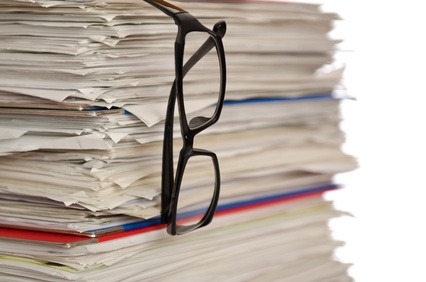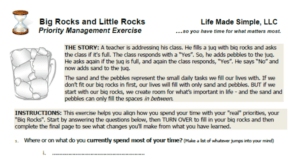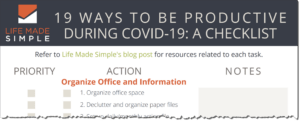
by Lori Vande Krol | Nov 20, 2023 | General Productivity, Goals and Priorities, Organization, Planning, Time Management, Tools
There is no question this is a busy time of year. But as we near the end of 2023, there are still a few things you can do to close out the year and prepare for a successful 2024.
1. Spend time on office “maintenance. Schedule a few days to catch up on filing, update your contact database, organize your receipts for the year (send them to Shoeboxed and let them take care of it for you!), empty your email inbox, and/or scan in those piles of paper (I recommend the Fujitsu ScanSnap iX1600 for PC or Mac for this task.) I like to use the last week of the year for these maintenance items. Spending some time to maintain your office productivity systems will help you feel you can start the New Year fresh and accomplish your goals.
2. Fill a bag for donation. Get a trash bag (or box depending on the type of items) and take 10-15 minutes to fill it with items to donate. Drop them off at a shelter, church, Goodwill, Salvation Army, or the charitable organization of your choice before the end of the year to receive your 2023 tax deduction. Help others that may not be as blessed during the holidays and clear out your space at the same time.
3. Crush what’s left of 2023. Plan the remainder of your year to help you prioritize and be intentional about how you want to spend this busy time. Brainstorm a list of personal and work tasks you want to accomplish before yearend. Be sure to review your 2023 goals to determine what is left to accomplish and determine if and how you will do so. Once you have a list of tasks, schedule them. With about 6 weeks remaining in the year, when will you focus on each task? Check out the ProAction Planner as a helpful tool for planning and scheduling.
4. Reflect on the year. Review the good and bad from 2023. What went well? Where did you find challenges? What will you continue doing, start doing, and/or stop doing in 2024? Download and complete our Year in Review Template, using the button below, to help you through the process.
5. Create your 2024 goals. Determine three to five goals for 2024. Why are these goals important? What strategies will you use to reach your goals? What tools or resources do you need to accomplish them? Check out our past blog, Goal Setting is Hard, for more goal-setting tips.
While each of these takes some time and focus, the value received is well worth it. Be sure to schedule them in before your end-of-year calendar is full.

by Lori Vande Krol | Mar 24, 2020 | Email, Goals and Priorities, Organization, Task and Project Management, Technology, Time Management, Tools
The past several weeks with the coronavirus pandemic have been unprecedented. We are in an environment of fear, stress, uneasiness, and unknowns. While it will take time for us to work through these emotions, it is important that we also try to continue as normal in ways that we can control. Productivity expert Barbara Hemphill said, “Control the things you can, so you can cope with the things you can’t.” I think this is true now more than ever.
19 Productive Actions You Can Control
One byproduct of social distancing is that many of us have found ourselves with unexpected time on our hands – closings, canceled events and appointments, reduction in travel time on planes, trains, and cars, and for some, an unfortunate reduction in customers or client work. Why not utilize this time for tasks or projects you have been putting off or just haven’t had the time to address? Take some control by working on things that will strengthen and grow your business, your career, and/or yourself, and create a solid base for “after the virus.”
Below I share a list of 19 productive actions you can take now, along with tips, resources, and recommended tools to assist with the task. Don’t be overwhelmed by the length of the list. Instead, choose a few of the highest priority items for you and/or your business and focus on taking action on those first.
At the end of the article, I provide a free download that will allow you to more easily prioritize each item and track your progress.
Disclaimer: Life Made Simple sometimes partners or affiliates with companies providing products, applications, or services that we feel would benefit our clients. In these cases, we may receive a small commission on sales through our affiliate links.
Organize Your Office Space and Information
1. Organize your office space
Whether you have a room devoted to work or space within another room, a clear, organized area can help improve focus and productivity. Clear off your floor, desk, and other surface areas. Toss, recycle, shred, or donate any unneeded items. Leave out only those items that add to your productivity, peace, or joy.
2. Clean out and organize your paper files
Divide your files into action (items you are working on now) and reference (items you are keeping for tax/legal reasons or future reference). Label files alphabetically (e.g. client files) or topically. If you have more than one file drawer full of paper, consider numerical labels and an online inventory of your paper files using the Paper Tiger filing system.
3. Set up a daily and/or monthly action file system
An action file system such as this one by Smead allows you to file papers or cards by day and/or month as reminders to complete a task or to be easy accessible when you need them. Keep the file system in a desktop file
allows you to file papers or cards by day and/or month as reminders to complete a task or to be easy accessible when you need them. Keep the file system in a desktop file along with a few hanging files to hold quick reference papers.
along with a few hanging files to hold quick reference papers.
4. Declutter and organize your digital files
Depending on your current structure and content, decluttering and organizing digital files can mean something different for everyone. Start with this checklist of things to think about when attacking your digital world and then develop your unique plan.
5. Set up your email for productivity
Like digital file management, email management can differ depending on the application you use (e.g. Outlook or Gmail), how much email you receive daily, and whether you use your email app for other productivity tasks such as calendar, tasks, and contacts. Check out this past blog post to help you get started with The Only 5 Email Folders You Really Need.
6. Go paperless
Moving towards a paperless environment requires a good scanner. My favorite scanner for moving those piles of paper, notes, and business cards to digital form is the Fujitsu ScanSnap. It is the most expensive tool of all of the resources mentioned here, but well worth the cost if you work with a lot of paper, want to be more digital, and/or often work remotely.
7. Manage your contacts
Whether this means scanning or entering business card information, cleaning out old contacts and updating current ones (I use the Duplicate Contacts app for Android and Apple phones – there are many others!), or setting up a full-blown CRM (customer relationship management) system, contact management is a great way to spend some unexpected downtime.
Get Clear on Your Goals
8. Determine your rocks (what is most important)
If it has been a while since you really stepped back to evaluate what is important to you in business and life, this is a great time to get re-centered and focused on what matters most. I am happy to share an exercise I use with individuals and groups for this reason.
9. Develop your 2020 goals
Once you know your “rocks,” you can work to develop your goals for the remainder of the year. I am confident life will get back to normal and when it does, what will you focus on for the remainder of the year? It’s okay if your goals aren’t perfect right now. Just get something on paper and then reevaluate once the pandemic has passed.
Analyze and Manage Your Time
10. Analyze your time management habits
When it comes to time management, have you ever wondered where you excel? And where you could improve? Spend some time looking at your strengths and weaknesses and make a plan for continuous improvement. If you’d like help with this reflection and/or putting systems in place to better manage your time, please contact me. I’d love to help!
11. Start using a daily time management tool
Now may also be the perfect time to review a few different time management tools to see what might work best once we get back to our hectic lives. Of course, my favorite is the ProAction Planner. [Update: Check out this article from Well + Good listing the top planners for 2025.]
Practice Risk Management
12. Back up your files
You have many options for backing up files, photos, email, and other digital information:
13. Evaluate your financial position
For businesses, utilize your current financial tool to review your actual results versus goals to date in 2020. How will this downtime impact your goals, if at all? If you are not using a financial tool, consider implementing one. Quickbooks, Freshbooks, and Xero are popular options. (Before introducing a tool such as these, be sure to do a technology needs assessment to ensure you are choosing the right tool for your needs. Last month’s blog shares a list of things to consider when analyzing a new or improved technology tool.)
Individuals should also review the impact of the pandemic on their financial position and develop a resulting budget and plan for the rest of the year.
Work on Yourself
14. Learn or fine-tune a skill
Skillshare, is a great resource for videos and training resources for a variety of skills. And, the first 2 months are free! A quick search on YouTube or Google will provide many more options.
15. Read a book
While I’m sure you have your own list of “must-read books,” a few non-fiction books I recommend (depending on your need and interests) are:
Building a StoryBrand: Clarify Your Message So Customers Will Listen
Atomic Habits: An Easy & Proven Way to Build Good Habits & Break Bad Ones
Unstoppable: A 90-Day Plan to Biohack Your Mind and Body for Success
I have a long list of recommended fiction books as well. Let me know if you are interested, or share your favorites in the comments below.
16. Get/stay healthy (exercise, meditation, healthy eating)
Getting and/or staying healthy when stuck at home takes a little bit of work. Since my normal workout location is closed, I joined an on-demand site with videos of the classes I normally take and purchased an inexpensive weight set on Amazon.com. Many workout locations and online exercise sites are providing free challenges, workouts, and videos. In addition, you can find several meditation, yoga, and recipe or meal apps in your phone’s app store.
17. Spring clean your home
Okay, I know this isn’t really “working on yourself” but It is a great way to feel better about yourself and your environment, and a clean, clutter-free home can help you feel more productive in your home office. Here are a few Spring Cleaning Checklists to track your progress. I chose to use the third as I felt it was the most inclusive and I liked that it gave me space to add my own tasks.
The Happier Homemaker
Freebie Finding Mom
Imperfect Homemaking
Give Back
18. Send cards, texts, or emails
Make someone feel a little less lonely or just make someone smile with a note of thanks or encouragement.
19. Help others
Giving can be financial, but doesn’t have to be. Drop off needed supplies or other physical donations, safely volunteer your time if you are healthy and able, or donate blood. You might also share your expertise or knowledge to help others in areas of need during this time, as is my hope with this blog. Buzzfeed and PBS share lists of other ways to help during the pandemic. And this article from Bankrate provides a unique idea – giving back utilizing your credit card rewards points.
Free Downloadable Checklist
I realize this is a long list! Not every item will apply or be important to every reader. In order to prioritize and track your unique action list, I am providing a free, downloadable checklist below. Be sure to refer back to this blog for the supporting resource links.
If you are in need of assistance, coaching, or support related to any of these tasks, please reach out via my contact page or by scheduling your free 30 minute productivity assessment. All of my work can be done virtually via phone or video call.
I wish all of you health, safety, love, and peace over the coming weeks and months. Spend time with family, call your friends, give back, focus on you, and control what you can.

by Lori Vande Krol | Mar 15, 2019 | Delegation, Organization, Procrastination, Time Management
Clutter is delayed decisions – whether it be paper clutter, email clutter, mind clutter or any other type of clutter in your home or office. Piles start because you are postponing making a decision on an item…then another… then another… So how can we simplify the choices that we need to make each day?
Following are 5 tips to help simplify your decision-making and reduce your piles.
Delegate
What could be better done, or used, by someone else? Choose those things that you love to do or love to look at and find someone else to take care of the rest. If you need help determining what to handle yourself and what to delegate, or donate, don’t be afraid to call in a professional or an unbiased friend to assist.
Gain Perspective
Try to step back and see yourself as others see you in your situation. This can serve as a reality check and open your eyes to things you have been avoiding. If you are having trouble with this exercise, find someone you trust and ask for his or her opinion — but be ready for the answers and keep an open mind.
Use a Timer
When a task seems overwhelming, or when you find yourself spending all day researching a decision on the internet or clearing out your email inbox, a timer is a wonderful tool. Set it for 10 minutes, 30 minutes or 1 hour depending on the task. Work diligently during this time to make the appropriate decision(s). The task will seem less overwhelming and take much less energy.
Have a System
Having the appropriate systems and tools in place is very important in simplifying your decision-making. For example, the ART System™ works wonderfully for addressing your paper and electronic “piles.” Every item should either be acted on (or delegated to someone else to act upon), filed away for future reference, or tossed. With effective tools in place that work for your needs and personality, these decisions become much simpler.
Let Go of Perfectionism
You might be surprised at how many of my clients are perfectionists. They say they are cluttered and disorganized because if something can’t be perfect, they don’t want to do it at all. Sound familiar? As a recovering perfectionist myself, I completely understand this feeling. But sometimes you need to determine that ‘good is good enough’ and move on. One way I have found to address this issue within my home is to hire a cleaning lady (see #1 – Delegate). If I clean my own home, I would spend far too much time on the picky details, while she is not only much more efficient at cleaning my home, but she knows when good is good enough.
Another tip for addressing perfectionism is to repeat to yourself a phrase I learned from a mentor, Barbara Hemphill. Barbara often says “Doing something is better than doing nothing at all.” If I didn’t believe and live by this phrase every day, you might not be reading this article right now. Is it perfect? No. Is it good enough. I hope so.

by Lori Vande Krol | Dec 12, 2017 | Organization, Technology
In the realm of digital information management, the storage and organization of photos may be one of the most difficult things to master. With digital cameras, we can now shoot an unlimited number of photos easily, and editing programs allow us to customize the look of photos in just about any way imaginable. In addition, the options for storing and organizing photos, and the features available within these programs, can make your head swim. To make the process more manageable, you should first answer some important questions.
1. How much space do you need to store digital photos? The size of a photo file can range from as low as .1 Mb to over 100 Mb depending on quality and use. Determine your average photo size and number of photos to determine the storage space you need now and in the future. Or if you have your photos currently stored in a folder, check the storage size of that particular folder to get a feel for your current needs. How might this grow over time?
2. Do you need to access your photos online? Will you be storing and accessing your photos from one computer, or would you like to be able to access them from any computer or mobile device? One construction client I worked with wanted to be able to view photos of projects while on the job-site. You may also want to use an online program as a way to back up or archive your photos. There are many good cloud-based programs for storing and organizing photos with varying features and price.
One example is a Google application called Picasa. One great feature of Picasa is the ability to store your photos on your computer’s hard drive for organization, renaming, tagging, face recognition, location information and basic editing. An automatic sync will then upload the photos to Google+ so that you can access them at photos.google.com using your Google account. Any changes you make to the photos in Picasa will continue to sync with your online albums. You can then also share your photos within your Google+ Circles. An added benefit is the ability to use a mobile app on your phone or tablet to upload any photos from these devices. Apps are available with both the Android and iOS systems. Of course, iPhoto is a similar program available on Apple devices with the ability to upload to the iCloud.
If you decide to use an online storage service, be sure to review and be comfortable with the Terms & Conditions and Privacy Policy for the service. For example, Google’s Terms of Service explains that you retain the ownership rights to your photos, but Google is allowed access to them in order to provide you the service and to improve on the product.
3. How often, if ever, do you need to order prints of your photos? If you order prints of your photos often, an online program such as Snapfish or Shutterfly may be a good solution. With these programs, you can store and organize your photos as well as perform basic editing features. But if you don’t continue to order prints, your photos will not be stored beyond a certain amount of time (typically one year).
4. Will you be doing professional editing of your photos? The programs mentioned so far allow editing features that are typically sufficient for the novice photographer. If your editing needs are more advanced, you can look at a program such as Adobe Photoshop Elements 12.
5. What is your budget? As mentioned, there are a wide range of solutions available and some are free. Price will increase with storage size, features available and the availability of advanced editing.
Note that many digital cameras come with their own organization and editing software. If you have basic needs for photo storage and organization, this may be a good solution.
I’d love to hear what you use for your photo organization and storage. Please share your comments on our Facebook page.

by Lori Vande Krol | Jul 12, 2017 | Organization, Technology, Tools
The information we can choose to read each day is growing at an enormous rate due to the availability of digital information. Taking into account email messages and attachments, online articles and stories, information shared via networks and cloud systems, and the vast array of social media options, we can spend our entire day in reading mode. In last month’s article, I discussed tips and tools for managing your reading materials that are in paper form. This month, I promised to focus on ideas for managing your electronic reading information.
Steps for management of digital reading:
1. Acknowledge that you can’t read everything. Unsubscribe from email lists that don’t provide you value. Delete information that doesn’t apply to your personal or professional vision and goals. The more you can declutter, keeping only that which applies to your current values and goals, the less stress and overwhelm you will feel.
2. Categorize your information by type.
- Is it necessary for a current project or training need (active reading)?
- Are you keeping it for a future project or “just in case” you may need it (reference reading)?
- Is it leisure reading, or perhaps a quick read that will either be deleted or stored as reference once you are finished (for example, an email newsletter)?
3. Determine how and where you will store your information. This should depend on the type of reading as determined above. For example, email newsletters might be stored in a “To Read” folder, or you might save them to your hard drive or an online system such as Evernote, Dropbox or iPEP(the system I personally use, which allows me to forward emails and attachments directly to my iPEP online workspaces). If a message or attachment is related to a current or future project, consider attaching it to your task or reminder system so it is available when and where you need it.
4. Regardless of where you store your electronic reading, it should be organized in a logical way that allows for easy retrieval. Using good titles, tags and keywords will enhance your ability to search for information. And, if your digital reading is stored in OCR (optical character resolution) format, your search program can search content within the document as well. Programs such as Adobe Acrobat Standard or Pro allow you to scan and convert documents to OCR format.
Once you have decluttered, defined and categorized your digital reading materials, and you have developed a basic organizational structure for storage and retrieval, you can begin to enhance your structure with helpful add-ins and applications. One of my favorites is Pocket, a free application for desktop and mobiles devices that allows you to save articles, videos, etc. in your electronic “pocket.” If it’s in your Pocket, you can view it later on any of your mobile devices, with or without an internet connection. Instead of using those free minutes to surf Facebook, catch up on some reading! A helpful tool for email newsletters is Unroll.me, which is offered for Gmail and Yahoo email users. Unroll.me allows you to roll subscription emails into a daily digest. You can then review them at one time instead of being distracted by several throughout the day.
I’d love to hear what reading tools and apps you love to use! Please share your favorites on our Facebook page.

by Lori Vande Krol | Jun 12, 2017 | Organization, Tools
One of the most popular questions I get from clients and workshop attendees is how to handle the plethora of “things to read” we receive on a daily basis. This could include magazines, articles, books, email newsletters, internet-based information, or educational materials received from conferences or workshops. We collect these materials for many reasons, including:
• For research
• To stay current
• Pleasure
• Education
• Skills Development
• Idea Generation
• Project/client-related reading.
As someone who loves to read for business and pleasure, and strives to stay on top of the latest news, tools and information in my industry, I have also struggled with how to manage all of the related information. The next two Simpler Times will share techniques for dealing with this often overwhelming piece of information management. This month I will discuss general tips for managing your reading materials and share tools specifically for paper information. Next month, I will focus on tips and tools for reading information that is in electronic form.
Steps for management of reading and educational materials:
1. Gather all of your materials in one place, or make a list if that is not feasible. Sort by priority and context. For example, is it leisure reading? Is it strictly educational? Is it related to a current project? Or is it related to a project you would like to do in the future?
2. Acknowledge that you can’t read everything. Unsubscribe from magazines and newsletters that don’t provide you value. Delete or recycle information that doesn’t apply to your personal or professional vision and goals. Consider selling books at a resale store such as Half-Price Books or on www.Amazon.com. The more you can declutter your reading materals, keeping only those that apply to your current values and goals, the less stress and overwhelm you will feel.
3. Determine how and where you will store your information.
- Books and binders should be stored on a bookcase in a format that works best for you. Perhaps this is by reading type, or alphabetically. You might have a different location for books that are current reading or those you plan to read within the next 30 days.
- Magazines can be stored in magazine files on a bookcase or within a hanging filing system if they are not too large. These may also be stored by type or alphabetically. Those relating to a specific project might be stored with that project file. Magazines that are kept for leisure reading can be stored in basket or bin near where they will be read, maintaining a limit on how full that container will get before older ones are recycled or perhaps passed along to someone else. Also, consider tearing out the specific article you need and recycle the rest of the magazine.
- Articles and newsletters should be stored in a hanging filing system. There are 3 basic types of reading information kept in the form of newsletters and articles. (1) Those that are kept for leisure reading might be stored in a “To Read” file. The file can then be reviewed when you know you will have some time — for instance, on a plane trip or heading to an appointment where you may be kept waiting. (2) Articles or newsletters that are time sensitive should be stored in a location that will ensure they are read as needed. You might use a tickler file system and file the article in the appropriate date’s folder. (3) Articles related to a specific project – either current or future – should be stored in that project’s file. This “Just in Time” reading isn’t necessary until it is time! Filing it away in the appropriate location will help ensure it is not forgotten and that it will be there when needed.
4. Do you fear putting your reading materials away because you are afraid they will be forgotten? A great way to address this is to index your files and information. Indexing will ensure you can find what you need, when you need it. For this, you can use a basic Excel spreadsheet, an indexing program such as Taming the Paper Tiger or an file storage and collaboration system such as iPEP. The benefit of the last two programs are that you are able to coordinate your paper reading with your electronic files. I will cover this more in next month’s newsletter. If you would like a copy of an Excel template for indexing your information, please email me directly. In addition to an indexing system for finding your reference materials, it is important to schedule any specific tasks related to reading in your task management system. Reading related to current projects or goals should be scheduled for the appropriate date. Reading related to future projects or “someday maybe” projects can be kept on separate task lists.
5. Maintain your new system for managing reading information by setting retention dates for all information types. Determine how long the materials should be kept and stick to your plan. Periodically review your vision and objectives and make sure your “to read” list continues to fit with current goals.
Take some time over the next couple weeks to develop a system and process for your paper reading materials. You might also consider scanning much of your paper reading information to an electronic format. Or if is already in digital form, consider whether you really need to print it. And, watch for next month’s blog to learn some fun and valuable tools for managing your digital reading information.









Recent Comments